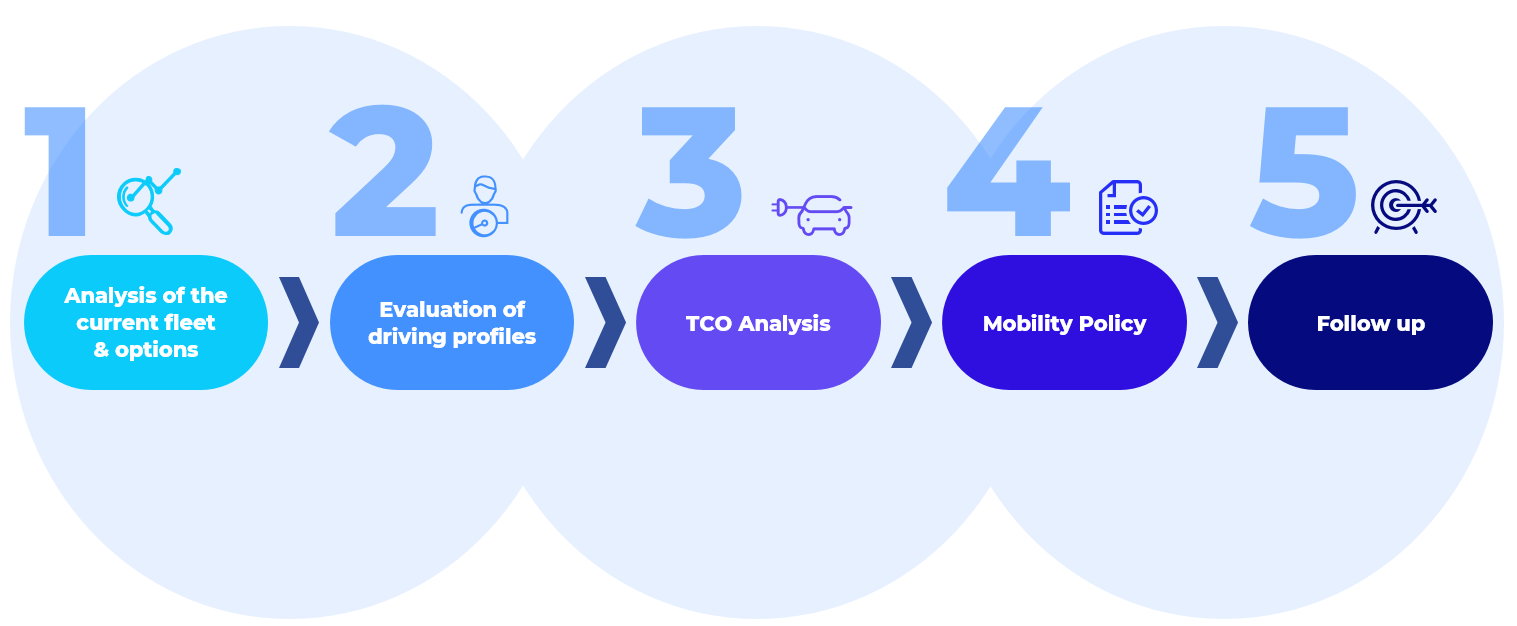What to look for in your new e-car policy
The creation of an internal company car policy is an extremely complex undertaking. Not only should the vehicles meet the needs of company car drivers, but the cars chosen also project the company's image to the outside world. E-vehicles in particular are a popular tool to showcase the company's sustainability and environmental strategy. However, as the implementation of such vehicles in the car policy can involve some hurdles and conversions, our blog post is dedicated to this very topic. Based on 5 steps, we explain what is important when creating an e-car policy.

1. Analysis of the current vehicle fleet
Before the car policy is revised, a precise overview of the current vehicle fleet should be created. Important points here are the number of vehicles and their mileage, existing vehicle brands and models, but also the topic of charging solutions.
This analysis provides a first rough overview of how much effort a conversion to e-mobility means in your case or if it makes sense at all. Above all, the mileage and the vehicle models play an important role here. In this first step, you can already check whether the ranges of current e-vehicles meet the requirements and if suitable vehicle models are also available in fully electric versions.
You should also consider the topic of charging options in the early stages of the car policy. For example, it should be determined whether charging at the workplace is possible for company car drivers, a subsidy is granted for the installation of a wallbox at the private address, and where and with which charging cards one may use the public charging network. To avoid surprises, the tax aspects of these three charging options must also be considered in each case.
In this step, other forms of mobility can also be integrated into the considerations. For example, employees without a company car could be provided with a ticket for public transportation or a company bicycle.
2. Evaluation of driving profiles
An equally important issue is the collection of driver profiles. The easiest way to do this is to conduct a survey. In addition to the daily distances traveled, it should also be determined how often private and professional long-distance trips are made. The general willingness to use e-mobility and the charging situation in the private environment should also be questioned. The results of this survey will provide information on which people and to what extent a switch to fully electric vehicles makes sense. If long distances without charging possibilities are often driven, it may be ecologically as well as economically more sensible to equip individual company car drivers with a plug-in vehicle.
3. TCO analysis
The next step is to look at the costs of switching to e-mobility. The exact definition in advance should be emphasized here. Please note that while fully electric vehicles can sometimes be significantly more expensive to purchase, they are less expensive to maintain. This is because, compared to a diesel or gasoline car, e-cars consist of fewer wear parts due to their design. Cost limits should therefore be set based on a TCO (Total Cost of Ownership) analysis. Here, not only the pure acquisition costs are taken into account, but also all incidental costs such as service appointments, tires or refueling or loading. The e-car often emerges from this analysis as the more favorable choice.
If the vehicle is financed by means of a full-service leasing contract, not only are the acquisition costs eliminated, but you also know before the leasing period begins how high the monthly installment will be. This increases the company's liquidity. In addition, in this case the lessor bears the risk of the residual value at the end of the term.
4. Car policy
With the previous points completed, you can now set up the car policy. On the one hand, it should specify which vehicles the drivers can choose from and where the cost limit is. On the other hand, it must also be specified how and where the electric vehicles may be charged. The subsidy for the installation of a wallbox at the company car driver's home - if this is granted - should also be included in the car policy. It must also be mentioned what happens to the wallbox as soon as the employment relationship is terminated. Possible procedures would be: the transfer of ownership to the driver, the possibility to purchase the wallbox or the uninstallation of the wallbox. To avoid ambiguities, the charging cards to be used for the public charging network should also be specified.
Once the car policy is finalized, a process must be defined to ensure that it is read and signed by each driver before receiving the vehicle.
5. Follow Up
The electrification of the vehicle fleet should also be used to train company car drivers in the use of their new cars. Especially when it comes to charging and energy-saving driving, there are many dangers lurking, which can manifest in high charging costs or consumption. It is therefore advisable to provide drivers with guidelines, assistance and competent contact persons. In this way, the switch to e-cars can be made without any problems.
As a general rule, the car policy should be regarded as a "living" object. Due to rising vehicle and charging prices, the defined cost limits and charging options in particular should be regularly scrutinized.
With these tips, you are now well equipped to make your car policy fit for electromobility.